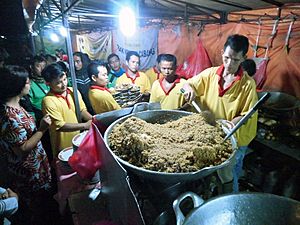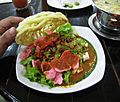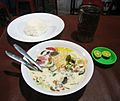Betawi cuisine facts for kids
Betawi cuisine is a mix of many different foods. It comes from the Betawi people, who are a blend of groups from all over Indonesia. They also mixed with traders and visitors from China, India, Arab countries, and Europe. These people came to the port city of Batavia (now Jakarta) a long time ago. This mix of cultures made Betawi food very rich and varied.
Contents
How Betawi Food Grew
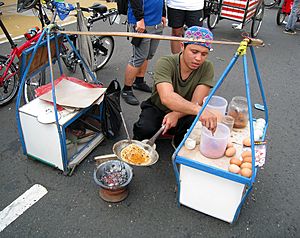
Betawi food changed and grew with new people arriving in Batavia. This city, once called Sunda Kalapa, became a busy trading center. Traders from Indonesia, China, India, and Arab lands visited often. In the 1500s, the Portuguese were the first Europeans to arrive. The Dutch came later.
During the Dutch rule, different groups lived in their own areas. This led to special foods in each place. For example, Tanah Abang became known for Arab food. Glodok and Kuningan were famous for Chinese food. Tugu in North Jakarta had Portuguese influences.
Betawi food is much like Peranakan cuisine. Both are a mix of Chinese and Malay styles. They also have touches of Arab and European cooking. Even foods from nearby Sundanese and Javanese cuisine are part of it.
For example, Nasi uduk is rice cooked in coconut milk. It is served with many side dishes. This might be a local version of the Malay dish nasi lemak. Asinan is a salad of pickled vegetables. Rujak juhi has vegetables with dried squid and peanut sauce. These show Chinese influences.
Some Betawi dishes are also found in Chinese Indonesian food. These include asinan and lontong cap go meh. Betawi food also shares dishes with the Sundanese. They both enjoy sayur asem, gado-gado, and semur jengkol. Dishes like nasi kebuli and soto betawi use minyak samin (a type of butter). This shows influences from Arab or Muslim Indian cooking.
One expert thinks some Betawi dishes tell us about the past. Kerak telor was made because local glutinous rice was not very good. Adding egg and other toppings made it tastier. Soto tangkar is a meat soup today. But long ago, it was mostly made from goat rib bones. Meat was expensive, and many people could not afford it.
Today, some true Betawi dishes are hard to find. Jakarta is a big city with foods from all over Indonesia and the world. Betawi food has many dishes to compete with. Also, many Betawi communities moved out of the city center. But some Betawi restaurants are working hard to keep their traditional foods alive. These include rare dishes like gabus pucung and pecak gabus.
Ingredients and Cooking Styles
Betawi food uses rice as its main staple. Many dishes are made with rice. It can be steamed, cooked in coconut milk as nasi uduk, or pressed into cakes like ketupat sayur or lontong sayur.
Most Betawi people are Muslim. So, they prefer beef, mutton, and goat meat. They follow halal rules, which means they do not eat pork. Fish is also eaten. It is interesting that for a city by the sea, there are not many seafood dishes. But there are many dishes with freshwater fish. These include local snakehead fish and carp.
Some popular Betawi dishes are soto betawi (beef soup with milk), sayur asem (sweet and sour vegetable soup), and kerak telor (spiced coconut omelette). Most Betawi foods are deep-fried, stir-fried, barbecued, or braised. They have a nice mix of sweet, sour, and salty tastes.
Main Dishes
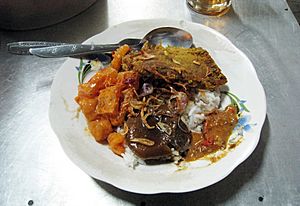
- Asinan betawi: A salad with pickled vegetables, noodles, and a sweet, sour, spicy peanut sauce. It is topped with rice crackers.
- Bakcang: Glutinous rice filled with meat and wrapped in a bamboo leaf.
- Bubur ayam: Rice congee (porridge) with shredded chicken and toppings.
- Empal: Sweet and spicy fried beef.
- Gado-gado: Boiled or blanched vegetables with peanut sauce.
- Kerak telor: A rice cake cooked with egg, shredded coconut, and dried shrimp.
- Ketoprak: Vegetables, tofu, rice noodles, and rice cake in peanut sauce.
- Ketupat: Rice dumplings cooked in woven palm leaf pouches.
- Ketupat sayur: Ketupat in a spicy vegetable soup with thin coconut milk.
- Lontong: Pressed rice cake wrapped in banana leaves.
- Lontong cap go meh: Lontong in rich coconut milk with chicken, liver, and other vegetables.
- Laksa betawi: A thick, yellowish soup with spices, dried shrimp, ketupat, vegetables, and boiled egg.
- Mi kangkung: Noodles with water spinach.
- Nasi biryani: Flavored rice cooked with vegetables, mutton, or chicken.
- Nasi goreng domba: Spicy fried rice with mutton, cooked in ghee.
- Nasi goreng kambing: Spicy fried rice with goat meat, cooked in ghee.
- Nasi kebuli: Spicy steamed rice cooked in goat broth, milk, and ghee.
- Nasi mandi: Rice served with roasted chicken, lamb, or other meat.
- Nasi tim: Steamed chicken rice with chicken broth soup.
- Nasi uduk: Rice cooked in coconut milk, served with many side dishes.
- Nasi ulam: Rice with vegetables and side dishes.
- Pecak gabus: Spiced snakehead fish dish.
- Perkedel: Fried patties made from potatoes, meat, or tofu.
- Pesmol: Spiced fish dish, often with carp or milkfish.
- Pindang bandeng: Milkfish cooked in a dark, sweet and sour soup.
- Roti buaya: Crocodile-shaped bread, often used for celebrations.
- Roti gambang: Rectangular brown bread with sesame seeds, flavored with cinnamon.
- Rujak juhi: Vegetables with shredded dried squid in peanut sauce.
- Rujak shanghai: Preserved seafood and jellyfish with vegetables and sweet and sour sauce.
- Sate kuah: Beef satay served in a rich, creamy, spicy soup.
- Semur jengkol: A pungent-smelling bean stewed in sweet soy sauce.
- Sayur asem: Vegetables in tamarind soup.
- Soto betawi: Beef offal soup with tomatoes and fried potato slices.
- Soto kaki: Beef or goat leg tendons and cartilage soto.
- Soto mi: Spicy noodle soup with yellow noodles and soto soup.
- Soto tangkar: Soto made from chopped beef ribs.
- Tahu goreng: Fried tofu with peanut sauce or sweet soy sauce and chili.
- Tauge goreng: Stir-fried bean sprouts with tofu, ketupat or lontong rice cake, and noodles. Served in a spicy sauce.
Snacks and Desserts
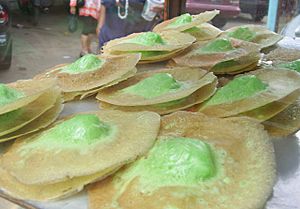
- Bubur cha cha: A dessert with sago, sweet potatoes, bananas, and coconut milk.
- Bubur sumsum: White congee made from rice flour, eaten with brown sugar sauce.
- Cakwe: Fried long bread, served with a sweet, sour, and spicy dipping sauce.
- Cincau: A jelly-like dessert.
- Dodol: A sticky sweet treat made of coconut, glutinous rice, and brown sugar.
- Emping: Crispy crackers made from Gnetum gnemon nuts. They have a slightly bitter taste.
- Geplak: Sweets made from sugar and grated coconut.
- Kembang goyang: A traditional snack made from rice flour, eggs, sugar, and coconut milk.
- Kue ape: A soft cake with a crispy edge.
- Kue cubit: A small pancake made with flour, sugar, and milk.
- Kue cucur: A pancake made of fried rice flour batter and coconut sugar.
- Kue gemblong: A rice flour dough covered in sticky brown coconut sugar.
- Kue pancong: A sweet coconut hot cake.
- Kue pepe: A sticky, sweet layered cake made of glutinous rice flour.
- Kue putu: A green, cylindrical steamed cake.
- Kue putu mayang: Rice noodles with coconut milk and liquid palm sugar.
- Kue rangi: Coconut waffle served with thick brown coconut sugar.
- Kue talam: A traditional cake made of rice flour, coconut milk, and sugar, steamed in molds.
- Lumpia jakarta: Deep-fried spring rolls, usually filled with jicama. Served with spicy peanut sauce.
- Pastel de nata: An egg tart pastry from Kampung Tugu, influenced by Portuguese cuisine.
- Semprong: A crispy wafer snack.
- Wajik: Diamond-shaped sweet glutinous rice cake.
Drinks
- Bir pletok: A non-alcoholic drink made from the bark of the secang tree.
- Cendol: An iced sweet dessert with green rice flour jelly, coconut milk, and palm sugar syrup.
- Es cincau: Grass jelly drink served with shaved ice, coconut milk, and sugar.
- Es selendang mayang: A sweet iced dessert with liquid palm sugar, coconut milk, and cakes made from rice flour.
- Sekoteng: A warm drink made of ginger and milk. It has peanuts, cubed bread, and tapioca pearls.
Gallery
-
Asinan betawi, pickled vegetables in peanut sauce.
-
Gado-gado, vegetables in peanut sauce.
-
Kerak telor, spicy coconut omelette.
-
Ketoprak, vegetables, tofu, rice vermicelli and rice cake in peanut sauce.
-
Ketupat sayur, ketupat rice cake in spicy vegetables soup.
-
Laksa Jakarta style.
-
Mie kangkung, noodle with water spinach.
-
Nasi goreng kambing (goat meat fried rice) Kebon Sirih
-
Nasi ulam Betawi.
-
Sayur asem Betawi version.
-
Soto betawi, a Betawi beef meat and offals in rich and creamy milk or coconut milk soup.
-
Roti buaya, crocodile-shaped bread is often served in festive occasions.
-
Roti gambang, xylophone-shaped bread with sesame seeds.
-
Nasi kebuli with goat meat.



